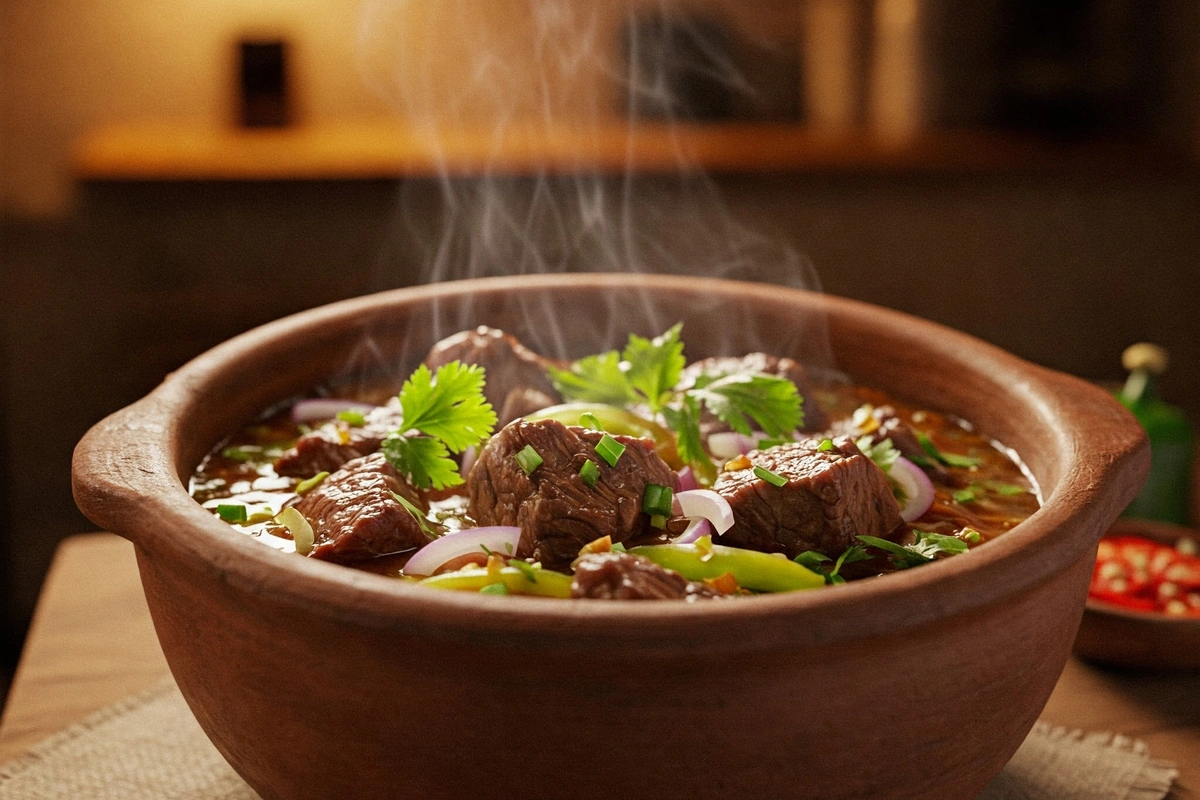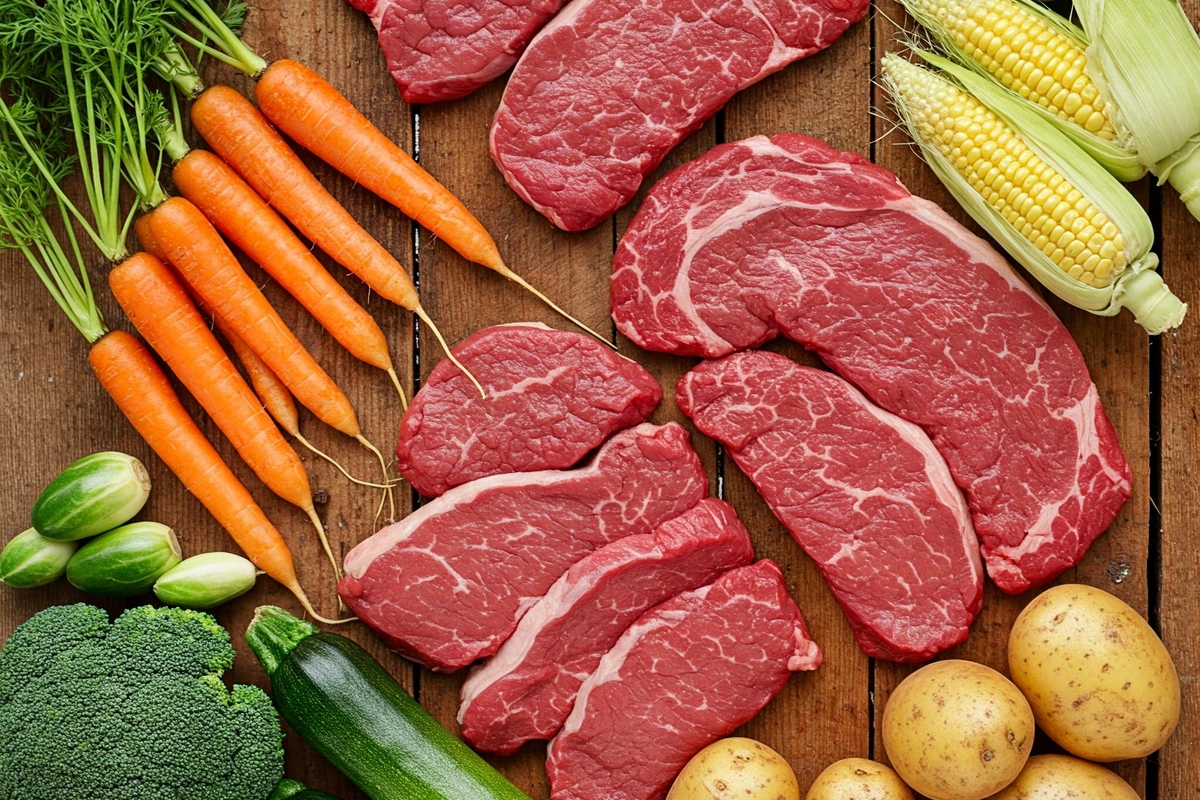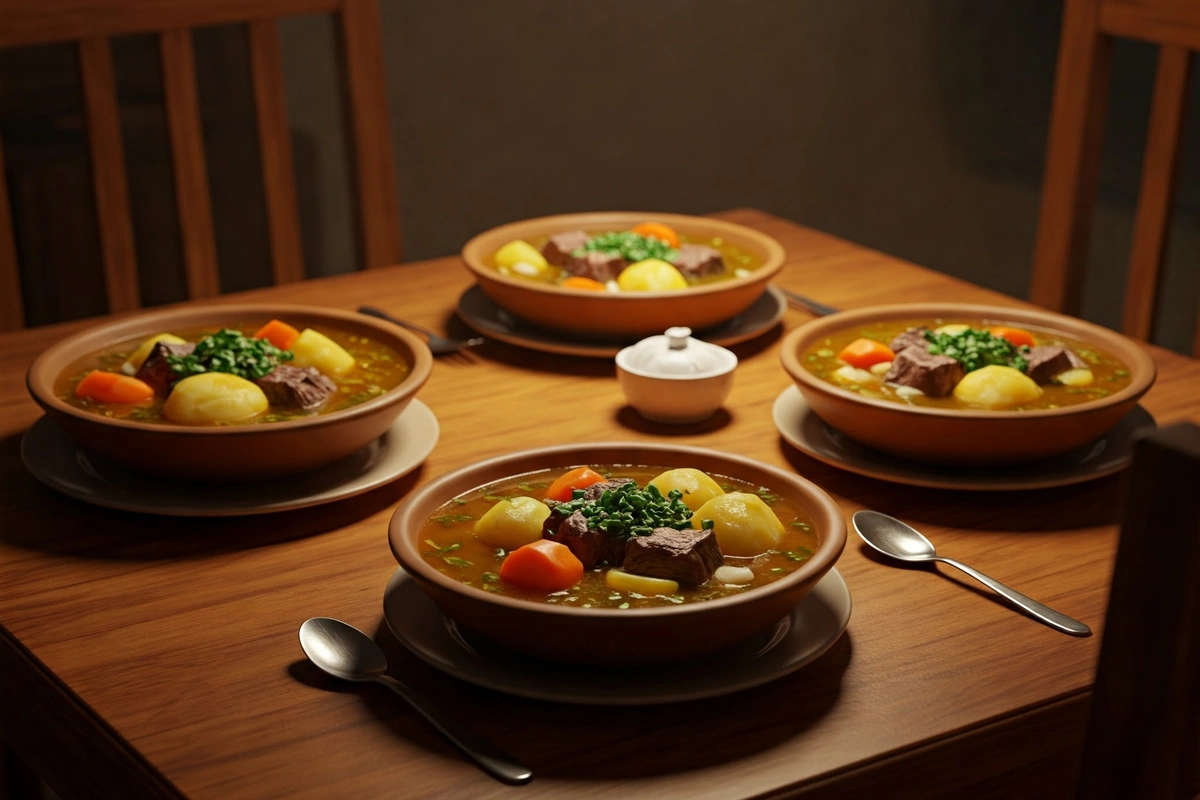Explore how Is Caldo de res healthy for you? reveals vital nutrients, potential benefits, and simple tips for a nourishing bowl of this classic soup.
Eating healthy does not have to be boring. Traditional dishes from around the world can offer both comfort and nutritional benefits. One beloved option is Caldo de res, a hearty Mexican beef soup. This savory stew combines beef and vegetables in a flavorful broth. People often enjoy it during cold weather or whenever they crave something wholesome. Yet many wonder, Is Caldo de res healthy for you? In this article, we will examine the soup’s nutritional background and assess its key health benefits and possible drawbacks. Furthermore, we will provide cooking tips to ensure you can make your bowl of Caldo de res even more nourishing.
Is Caldo de res healthy for you? An Introduction
Many traditional stews and soups rely on slow-cooking methods. This approach helps extract deep flavors from ingredients, while simultaneously making them tender and easy to digest. Caldo de res follows this principle. It calls for simmering beef with an assortment of vegetables in a pot of water or broth. Initially, this process can take at least an hour or more, depending on the thickness of the beef. However, the time investment pays off with a savory meal that is both hearty and comforting.
But is Caldo de res healthy for you? Generally, the dish offers valuable protein from beef along with vitamins and minerals from vegetables. Beef provides essential amino acids that support muscle repair and growth. Meanwhile, vegetables such as carrots, potatoes, squash, and corn provide fiber, antioxidants, and micronutrients. Because of these combinations, many people regard Caldo de res as both nourishing and comforting.
Still, the soup’s nutritional profile can vary based on the type of beef used, the quantity of fat, and the use of any additional seasonings. Accordingly, if you choose leaner cuts and fresh vegetables, you can reduce the overall calorie count while preserving the natural flavors. Conversely, fatty cuts might increase the soup’s saturated fat content. Therefore, making wise ingredient decisions is crucial if you want to keep the soup’s health benefits in check.
Is Caldo de res healthy for you? Traditional Preparation
Caldo de res typically starts with beef shanks or beef chuck. Sometimes, cooks use bones with marrow to enhance flavor and nutritional value. After washing and patting the meat dry, you can season it with salt and pepper. You then place it in a large stockpot with water or broth. Eventually, the soup is brought to a gentle boil and then reduced to a simmer. Next, onions, garlic, and tomatoes are often added to enrich the flavor base.
Later in the cooking process, vegetables such as carrots, potatoes, corn on the cob, chayote, zucchini, or green beans go into the pot. You let everything cook until the meat becomes fork-tender and the vegetables reach the desired softness. Herbs like cilantro can be included at the end for an extra aromatic note. Altogether, these steps yield a warm, satisfying soup. Considering these ingredients and methods, you might believe the answer to “Is Caldo de res healthy for you?” is indeed positive, although you must remain mindful of portion sizes.
Is Caldo de res healthy for you? Helpful Variations
Some variations focus on making Caldo de res lighter. For instance, you can trim visible fat from the beef and choose low-sodium broth. Alternatively, you can add more vegetables to increase fiber and nutrient density. Likewise, you may decrease the portion of starchy vegetables if you are watching your carbohydrate intake. Ultimately, these small adjustments can help you tailor the soup to your health needs.
Because this dish is adaptable, it fits easily into different dietary frameworks. For example, if you are monitoring sodium, you can add less salt and rely more on natural herbs and spices for flavor. If you want more complex carbohydrates, you can incorporate whole grains on the side, such as brown rice. Conversely, if you are on a low-carb plan, you can limit potatoes and corn and double up on zucchini or leafy greens. Undoubtedly, this flexible nature helps people answer, “Is Caldo de res healthy for you?” with a resounding yes, as it can be easily tweaked to meet various nutritional goals.
Is Caldo de res healthy for you? Expert Tips
Nutrition experts often suggest balancing your meal by being aware of portion sizes. Consequently, you should measure the amount of beef you add to each serving and ensure you are not consuming too much red meat per day. Additionally, consider complementing Caldo de res with a fresh salad or fruit to add more vitamins, minerals, and fiber to your meal. Altogether, these thoughtful steps can help maintain the soup’s wholesome character while supporting your overall health.
If you worry about calories, you can refrigerate the soup overnight and skim off the solidified fat from the surface before reheating. Basically, this technique helps reduce the saturated fat content without sacrificing flavor. Moreover, you can use lean beef parts, such as round or sirloin, to keep fat levels lower. Indeed, with expert tips and strategic modifications, the answer to Is Caldo de res healthy for you? leans positively.
Is Caldo de res healthy for you? Key Nutritional Factors
Beef soups, particularly those loaded with vegetables, can present a great deal of essential micronutrients. Although the primary protein source in Caldo de res is beef, the vegetables are vital contributors of vitamins, minerals, and phytochemicals. Especially noteworthy are the fiber content and possible phytonutrients from colorful vegetables like carrots and zucchini. Meanwhile, the broth itself becomes infused with nutrients from the slow cooking process.
Protein is crucial for maintaining muscle, tissue repair, and hormone production. Comparatively, beef is one of the best-known sources of high-quality protein. It also contains iron, which supports healthy red blood cell function. Furthermore, beef provides zinc and vitamin B12, which are important for immune function and neurological health. Hence, these attributes highlight why this soup can be beneficial in moderation.
Many people struggle with sodium intake, and soups can be a hidden source of excess salt. Therefore, choosing a low-sodium broth is important when preparing Caldo de res. If you are using pre-packaged broth, check the nutrition label. Indeed, you might be surprised at the salt content. Moreover, limiting additional sodium from seasonings ensures a healthier final product. Meanwhile, the vegetables supply potassium, which can help offset sodium’s potential negative impacts on blood pressure.
Another key factor is the presence of essential vitamins such as vitamin A, found in carrots. This vitamin supports vision and immune function. Additionally, tomatoes and peppers, often used in the soup base, offer vitamin C, which promotes collagen production and helps with iron absorption. Consequently, the synergy of these vitamins and minerals helps address various nutritional needs.
Table of Nutritional Information (Per 100g)
Below is a rough estimate of the nutritional content for Caldo de res made with lean beef and standard vegetables. Actual values can vary based on specific ingredients and cooking methods.
| Nutrient | Approximate Amount |
|---|---|
| Calories | 70-90 kcal |
| Protein | 6-8 g |
| Carbohydrates | 5-7 g |
| Fat | 2-4 g |
| Fiber | 1-2 g |
| Sodium | 150-300 mg |
| Vitamin A | 8-10% DV |
| Vitamin C | 6-8% DV |
| Iron | 5-7% DV |
| Potassium | 5-8% DV |
(“DV” refers to the recommended Daily Value, based on a 2,000-calorie diet.)
These values demonstrate that Caldo de res can provide moderate calories, decent protein, and beneficial micronutrients. Nonetheless, the soup’s exact health impact will hinge on portion sizes and specific ingredients.
Is Caldo de res healthy for you? Health Benefits and Risks
Caldo de res is often valued for its comforting warmth and the sense of well-being it imparts. On a chilly day, this soup can be an excellent source of nourishment. Furthermore, the high protein content can help maintain muscle mass. Consequently, many physically active individuals or people trying to recover from illness find this soup helpful.
Potential Health Benefits:
- Muscle support: Lean beef delivers quality protein and essential amino acids.
- Rich in vitamins and minerals: Vegetables supply various micronutrients, such as vitamin A, vitamin C, and potassium.
- Promotes hydration: Soups generally help with hydration because of their water content.
- Easy to digest: Slow-cooked meat and vegetables become tender and digestible, making it appealing for some individuals with sensitive stomachs.
- Versatile: You can modify the recipe to align with different dietary needs.
Despite these advantages, you must consider possible drawbacks. Red meat, when consumed in excess, has been linked in some studies to cardiovascular issues. However, moderation and using lean cuts are key. Additionally, if you load your soup with salt, the sodium level can soar. Consequently, that is a concern for individuals with high blood pressure or those needing to limit sodium.
Potential Risks:
- Excess fat and calories: Using fatty cuts or adding oil can raise the soup’s saturated fat content.
- High sodium: Overuse of salt or broth with added sodium could counter health benefits.
- Allergen considerations: If you are gluten-sensitive, ensure your broth or seasonings are gluten-free.
Nonetheless, these risks are easy to mitigate through ingredient selection and portion control. Ultimately, balancing the types of fats, proteins, and carbohydrates in your diet is essential.
Cooking and Serving Suggestions
Caldo de res is a flexible meal. Traditionally served hot, you can enjoy it on its own or with a side of tortillas, bread, or rice. If you want to add another layer of freshness, garnish with chopped cilantro, diced onions, or a squeeze of lime juice. Meanwhile, hot sauce or sliced jalapeños can give the soup a spicy kick.
Cooking Tips:
- Choose the right cut of beef: Opt for leaner cuts like round or sirloin to lower saturated fat.
- Control fat content: Skim away surface fat during cooking. Alternatively, chill the soup so that solidified fat can be removed before reheating.
- Enhance flavor naturally: Use herbs, garlic, onions, and peppers to add depth instead of relying on salt.
- Monitor cooking time: Beef can become tough if not cooked long enough. Consider a pressure cooker for quicker results, or let it simmer low and slow on a stovetop for added richness.
Serving Tips:
- Portion mindfully: A moderate serving size is usually around one to two cups, depending on your caloric and protein needs.
- Pair with nutrient-dense sides: Add a salad or fruit to balance your meal and broaden its nutritional profile.
- Adjust to taste: Spice or salt can be added at the table if needed, but be conscious of sodium levels.
By applying these tips, you can make your bowl of soup more aligned with a healthy diet and lifestyle. Indeed, such strategies ensure you do not have to sacrifice flavor for nutrition.
Storing and Reheating Leftovers
Leftover Caldo de res is often considered even more delicious the next day. The flavors intensify as the soup sits, making it a pleasant dish to prepare in large batches. Nonetheless, proper storage is vital to maintain food safety and quality.
- Refrigeration: Place leftovers in an airtight container and store them in the fridge for up to three to four days.
- Freezing: If you plan on keeping it longer, freeze the soup in suitable containers or freezer bags for up to three months.
- Reheating: Thaw frozen soup in the refrigerator overnight, then gently warm on the stove. Consider adding fresh vegetables or herbs to refresh the flavor.
This approach also makes meal prep simpler. Cook a big pot of Caldo de res on a weekend, then enjoy portions throughout the week. You can alter the soup each day by adding new vegetables or sides to keep it interesting.
Additional Nutrient-Boosting Ingredients
You can always take Caldo de res to the next level by adding nutrient boosters. Certain vegetables and herbs can improve the soup’s flavor profile and health benefits. For instance, adding leafy greens such as spinach or kale boosts the soup’s iron, calcium, and magnesium content. Consequently, it can become even more nourishing.
Try adding:
- Spinach or kale for extra iron and folate
- Bell peppers for vitamin C and antioxidants
- Beans for additional protein and fiber
- Okra for a thicker consistency and extra vitamins
- Root vegetables like sweet potatoes for complex carbs and vitamin A
Meanwhile, if you prefer a tangy flavor, a small amount of vinegar or lime juice can brighten the taste. Altogether, these small changes can help your Caldo de res stand out while contributing more valuable nutrients to your diet.
Incorporating Caldo de Res Into a Balanced Diet
Balance is fundamental in any dietary plan. Caldo de res can be part of a broader diet strategy that includes diverse protein sources, plenty of fruits and vegetables, and whole grains. While beef offers protein, you could also alternate with chicken or fish soups on other days for variety.
Sample Meal Plan Idea:
- Breakfast: Oatmeal with fresh berries and a spoonful of almond butter
- Lunch: A moderate bowl of Caldo de res with lean beef and extra vegetables
- Snack: Greek yogurt with honey or a piece of fruit
- Dinner: Grilled salmon, quinoa, and roasted vegetables
- Evening Snack: Herbal tea and a small handful of nuts
Such a plan ensures that you obtain nutrients from multiple sources. Consequently, you avoid relying solely on one type of protein or nutrient group. Moderation is key, and paying attention to your portion sizes can help keep your overall calorie intake in check.
Cultural Significance and Enjoyment
Food is not merely about nutrients. It also has cultural and social importance. Caldo de res brings families together around the table. Friends share stories while savoring the comforting warmth of the dish. Particularly in many Latin American households, weekends are dedicated to making large pots of soup for everyone to enjoy.
This tradition underscores the emotional satisfaction tied to this meal. Is Caldo de res healthy for you? Culturally, it can nourish the soul as well as the body. Indeed, it is comforting and fosters a sense of connection and nostalgia. Therefore, many people find they crave it not just for nutritional reasons but also for the emotional joy it brings.
Final Thoughts
Ultimately, the question Is Caldo de res healthy for you? has a multifaceted answer. The soup provides a blend of protein, vitamins, minerals, and hydration. It is especially nutritious when prepared with lean beef and plenty of vegetables. Nevertheless, paying attention to portion sizes, sodium content, and potential dietary restrictions is important. By following recommended cooking practices and mindful ingredient selection, you can maximize the health benefits of this traditional meal.
Caldo de res stands as a comforting, hearty, and adaptable dish. Additionally, it is a wonderful way to showcase the vibrant flavors of Mexican cuisine. By experimenting with different vegetables and herbs, you keep the soup exciting and healthy. While some considerations exist regarding red meat and sodium, you can address them through careful preparation. Ultimately, you need not compromise flavor for health. With Caldo de res, you can have the best of both worlds.
Therefore, the next time you ask yourself, Is Caldo de res healthy for you? remember that the dish can be a nutritious, protein-packed choice. Simply apply smart cooking tips and thoughtful portion control. The result is a warming meal that helps nourish the body without neglecting taste or tradition.
Frequently Asked Questions (FAQs)
Q1: How often can I eat Caldo de res if I want to maintain a balanced diet?
You can enjoy it once or twice a week, provided you use lean cuts of beef. Additionally, ensure you incorporate enough vegetables and watch the sodium level. Varying your proteins on other days also helps maintain a nutritionally balanced menu.
Q2: Is Caldo de res healthy for you? when using pre-made broth?
It can be, but check the sodium content in pre-made broths. Opt for low-sodium or reduced-sodium versions. Consequently, you can add herbs, garlic, onions, and peppers to amplify the taste without relying on salt.
Q3: Can I make Caldo de res in a slow cooker?
Yes, a slow cooker works well. Initially, brown the beef for added flavor, then place it in the slow cooker with vegetables and seasonings. Cook on low for six to eight hours or until the meat is tender. This method also allows flavors to develop thoroughly.
Q4: Does freezing Caldo de res affect its nutritional value?
Freezing can slightly alter texture but generally preserves the soup’s nutrients. Thaw and reheat it carefully to maintain quality. Adding fresh herbs or vegetables after reheating can restore some of its vibrancy.
These are just a few of the many questions people often have. Is Caldo de res healthy for you? If you choose lean cuts, moderate sodium, and add nutrient-dense vegetables, it can certainly fit into a balanced and health-conscious diet. Ultimately, this comforting dish can be a welcome addition to your meal rotation.



